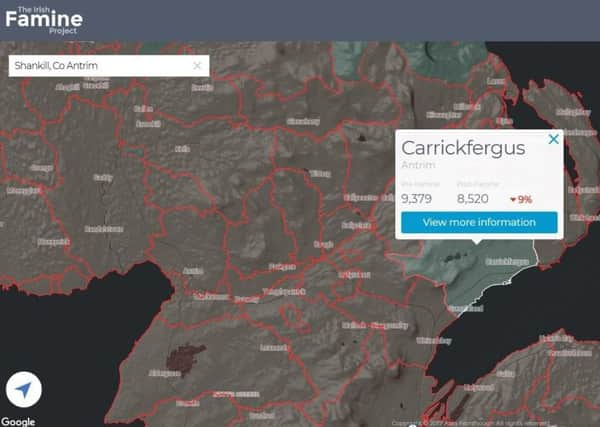Ulster weathered famine better due to '˜more egalitarian' farm system


Queen’s University researcher Dr Alan Fernihough also contends that Ulster wasn’t as badly impacted as some parts of Ireland because the farming system here was fairer.
Dr Fernihough said: “Some places in Ulster were decimated while others less so. The most interesting thing about Ulster was the Ulster custom with regard to land tenure.
Advertisement
Hide AdAdvertisement
Hide Ad“There was a lot fairer fixity of tenure. The farmers weren’t in as small farms as the rest of Ireland, they weren’t necessarily kicked off their land, there wasn’t all these sort of middle men. There was a more egalitarian set-up with respect to agriculture – because of that you had less effect.


“In 1847 the government brought in soup kitchens. There’s a number of districts in Ulster that didn’t set the kitchens up because their charities were operating through different churches.
“You can see the number of people claiming food rations in an electoral area for that day. In Mayo it could be 70% but in many parts of Ulster those numbers are zero.”
In order to produce an interactive map which shows the impact that the famine had on the Irish population during the 19th century, Dr Fernihough – Lecturer in Economics from Queen’s Management School – analysed a wide number of contemporary data sources, including the 1841 and 1851 Census of Ireland and the Poor Law Commissioner’s reports, in order to compile the repository showing the impact the famine had on the different civil parish areas.
Advertisement
Hide AdAdvertisement
Hide AdTalking about the findings from the study, Dr Fernihough said: “As expected, we found from the research that the population dramatically decreased after the famine due to the high number of deaths and high levels of people emigrating.


“However, we also found that in the larger city areas, the population increased post-famine.
“Cities such as Belfast, Dublin, and Cork increased in population size as people from the rural areas migrated into the larger cities in search of employment opportunities and relief institutions like the workhouse and fever hospitals.”
Ireland’s population is believed to have fallen from approximately 8.5 million to just over six million during the period of famine, with an estimated one million people dying and over one and a half million emigrating to Britain, the United States, Canada and Australia.
Advertisement
Hide AdAdvertisement
Hide AdThe map is the first interactive tool of its kind to combine these demographic, social, and economic data sets in any easy to use mobile-friendly website.
The Great Irish Famine, or the Irish Potato Famine as it also known, was arguably the single greatest disaster in Irish history, lasting from approximately 1845 to 1851.
The main cause of the famine was the failure of the potato crop for successive years, which resulted in mass starvation and death from sickness and malnutrition.